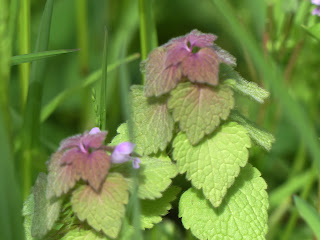Red Deadnettle
Continuing my encounters last April at the Raritan River Greenway [1], here's an abundant, early-flowering plant I saw. It's almost certainly a Red Deadnettle (aka Purple Deadnettle aka Purple Arcangel aka Red Henbit aka Deadnettle), but the plant is similar to and related to the Common Henbit (aka Greater Henbit aka Henbit Deadnettle aka Henbit). Much of what is true about Red Deadnettle is also true about Common Henbit.
Unlike Stinging Nettle but similar to Carolina Horsenettle, Red Deadnettle and Common Henbit are not nettles. Red Deadnettle and Common Henbit are instead mints. (Carolina Horsenettle is a nightshade.) They also don't sting the way nettles do; the name "deadnettle" came about because they look a bit like a nettle but with "dead stingers". The name "henbit" comes from its tendency to be eaten by chickens.
Both Red Deadnettle and Common Henbit are native to Eurasia and North Africa but can now be found across much of North America (among other places). While it's easy to find fault with any invasive species, these 2 plants are far from the worst offenders. They can be eaten by most omnivores and herbivores (including humans [2]), they are an early pollen/nectar source for pollinators, and birds can/will eat their seeds [3].
 |
| April 24, 2023 at the Raritan River Greenway Photo 272683330, (c) jpviolette, some rights reserved (CC BY-NC) |
[1] The Raritan River Greenway is the name of at least 2 trails along the Raritan River in my area. This part goes from around South Bridge Street to Raritan Valley Park. There might be an intention of eventually connecting them, though I suspect there's private property in between that precludes this.
[2] Before running out and gobbling up the deadnettle/henbit in your yard or park, you should make sure that pesticides or other human pollutants haven't been introduced into the environment. The plant itself isn't naturally poisonous, but it sure will be poisonous if it's been doused with rat poison.
[3] It's not clear to me that all the pollinators and birds know that these plants are a good food source, though it sounds like at least some of them have figured it out. That's the tricky thing about some invasive species: local animals frequently don't recognize their potential benefits.



Comments
Post a Comment